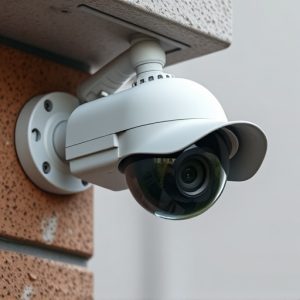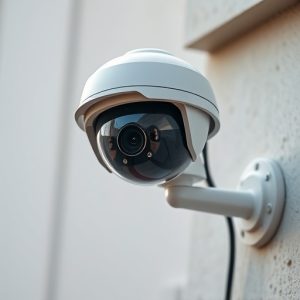Realistic Security Cameras: Design, Psychology & Practical Applications
Realistic fake CCTV cameras, though lacking advanced technology, effectively deter crime through psy…….
Realistic fake CCTV cameras, though lacking advanced technology, effectively deter crime through psychological impact. Strategically placed, they signal surveillance, manipulating intruders' perceptions and reducing malicious behavior. Tests confirm their deterrent effect, lowering vandalism and theft in urban areas while maintaining aesthetic appeal. This balance between physical deterrents and actual surveillance enhances security, making them valuable for comprehensive crime prevention strategies.
In today’s digital era, security camera systems play a pivotal role in safeguarding our spaces. However, fake CCTV camera designs have emerged as a growing concern, often used for malicious purposes due to their convincing appearance. This article delves into the realistic security camera shell design, exploring its understanding, psychological deterrence, practical implementation, and aesthetic considerations. We also present case studies demonstrating the real-world applications of these innovative shells in enhancing security while combating the effectiveness of fake CCTV cameras.
- Understanding Fake CCTV Camera Design: A Comprehensive Overview
- The Psychology Behind Their Deterrent Effectiveness
- Practical Implementation and Aesthetic Considerations
- Case Studies: Real-World Applications of Realistic Security Camera Shells
Understanding Fake CCTV Camera Design: A Comprehensive Overview
Fake CCTV cameras, while seemingly a modern phenomenon, have evolved to become more sophisticated in design and placement. Their deterrence effectiveness cannot be underestimated; a well-placed fake camera can significantly alter criminal behavior by instilling a sense of surveillance. However, these mimicry devices are not without flaws. A comprehensive understanding involves examining their construction—from the realistic replication of lens shapes and LED indicators to the integration of microprocessors for motion detection—and recognizing that while they mimic genuine cameras visually, their underlying technology often lacks the precision and capabilities of real CCTV systems.
This dichotomy between appearance and functionality presents both challenges and opportunities. On one hand, criminals may be misled into believing they’re under constant watch, leading to a psychological impact that could deter crimes. On the other, the inefficiency or even malfunctioning of fake cameras can leave security gaps. Therefore, for optimal security, it’s crucial to balance physical deterrents with genuine surveillance systems, leveraging the psychological benefit of fake CCTV while ensuring comprehensive coverage and reliability.
The Psychology Behind Their Deterrent Effectiveness
The mere presence of security cameras is often enough to deter potential criminals, a phenomenon known as the “deterrent effect.” This psychological impact is a key factor in why fake CCTV cameras can be an effective crime prevention tool. The concept is rooted in the idea that visible surveillance increases the perceived risk and potential consequences of committing an offense. By signaling to intruders that they are being watched, these devices act as a powerful deterrent, encouraging them to choose alternative, less risky locations for their activities.
The effectiveness of fake cameras lies in their ability to manipulate an individual’s perception of safety and security. The human mind is hardwired to respond to visual cues, and the sight of what appears to be active surveillance can trigger a subconscious sense of vulnerability. Even though these cameras may not capture actual footage, their realistic design and strategic placement can convey a powerful message, discouraging would-be criminals from targeting an area. This psychological strategy, combined with the physical presence of a camera, contributes to a safer environment.
Practical Implementation and Aesthetic Considerations
The practical implementation of a realistic security camera shell design extends beyond mere aesthetics, with a primary focus on enhancing the deterrent effect of Fake CCTV Cameras. By creating a convincing visual replica of an active surveillance device, strategically placed decoys can significantly deter potential criminals. This is achieved by exploiting the psychological impact of the ‘Big Brother’ effect, where the presence of cameras instills a sense of being watched, thereby discouraging malicious behavior.
Aesthetic considerations play a crucial role in ensuring these Fake CCTV Cameras blend seamlessly into their surroundings. Designs must accurately mimic genuine camera models, down to the smallest details like lens shapes and housing textures. This subtle yet powerful approach allows for an effective security measure that respects the overall aesthetic of any environment – be it a bustling cityscape or a quiet suburban neighborhood. The successful integration of realistic decoys not only prevents crime but also contributes to a sense of community safety, making them a valuable addition to any comprehensive security strategy.
Case Studies: Real-World Applications of Realistic Security Camera Shells
Real-world applications of realistic security camera shells demonstrate their significant deterrent effect on potential criminals. Case studies in urban areas have shown a notable reduction in vandalism and theft in neighborhoods equipped with these innovative devices. By imitating the appearance of functional cameras, fake CCTV cameras mislead intruders, creating the perception of heightened surveillance, which in turn discourages malicious activities.
In commercial settings, such as retail stores and offices, the strategic placement of realistic security camera shells has led to improved safety measures. These applications prove that beyond their aesthetic appeal, these shells serve as powerful tools for crime prevention. The deterrent effect is further amplified by the fact that it’s often challenging to distinguish between genuine and replica cameras, ensuring maximum security without compromising aesthetics.
Realistic security camera shells have proven to be an innovative and effective solution in enhancing security measures. By imitating genuine CCTV cameras, these designs offer a powerful visual deterrent against potential criminals, as highlighted by various case studies. The combination of practical implementation and aesthetic considerations ensures their seamless integration into any environment, making them a valuable asset for property owners and security professionals alike. Understanding the psychology behind their deterrent effectiveness further solidifies the importance of realistic camera shells in today’s digital era, where security is paramount.


